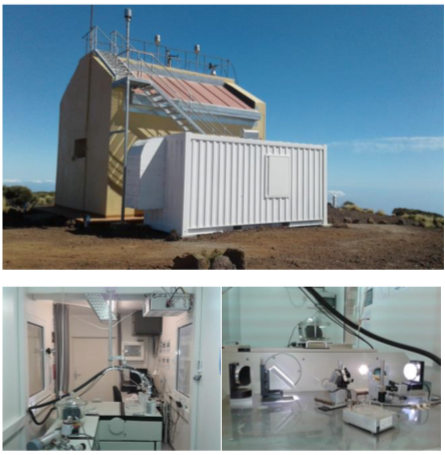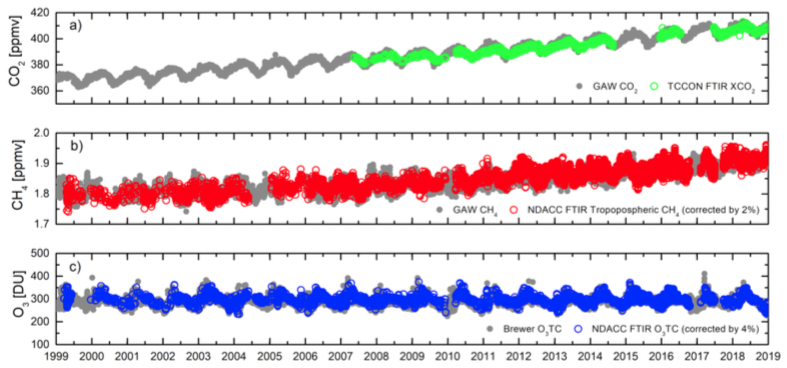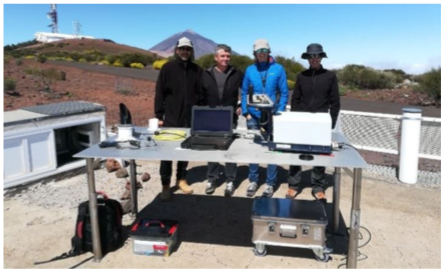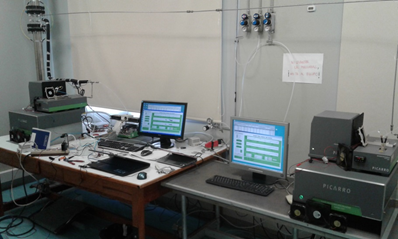Main Scientific Goals
Earth observations are fundamental for investigating the processes driving climate change and, thus, for supporting decisions on climate change mitigation strategies. Atmospheric remote sounding from space and ground are essential components of this observational strategy. In this context, the Fourier transform infrared spectroscopy (FTIR) programme at the IARC was established with the main goals of long-term monitoring of atmospheric gas composition (e.g. ozone and ozone-related species, greenhouse gases, air quality gases,…) and the validation of satellite remote sensing measurements and climate models.
Measurement Programme
Ground-based high-resolution FTIR Spectrometry
In Fourier transform (FT) spectrometry, the source radiation (typically the Sun for atmospheric ground-based measurements) is modulated by an interferometer and all optical frequencies are recorded simultaneously in the measured interferogram. Then, a mathematical FT is used to retrieve the atmospheric absorption spectrum from the interferogram. The application of the FT measurement technique in the IR spectral region has a well-known capability for atmospheric gas monitoring, and therefore for climate research, since most atmospheric molecules interact with solar electromagnetic radiation in this spectral region.
A ground-based high-resolution FTIR experiment (HR FTIR in the following) for atmospheric composition monitoring has two main components (Figure 1): a precise solar tracker that captures the direct solar light beam and couples it into a high-resolution Michelson interferometer (IFS). IARC’s FTIR activities started in 1999 with a Bruker IFS 120M spectrometer, which was replaced by a Bruker IFS 120/5HR spectrometer in 2005 that has been operating until present.

Figure 1: The ground-based FTIR experiment at the IARC (scientific container, upper panel, hosting the Bruker IFS 120/5HR spectrometer, lower panel).
The IZO FTIR instrument records direct solar spectra in the middle- and near-infrared spectral region (MIR and NIR, respectively), using a set of different apertures, narrow-bandpass filters and detectors. Within the NDACC activities, solar measurements are acquired between 740 and 4250 cm-1 with a spectral resolution of 0.005 cm-1, while for TCCON retrievals the NIR spectra are taken between 3800 and 9000 cm-1 at a spectral resolution of 0.02 cm-1.
By evaluating the spectral signatures of vibrational-rotational transitions contained in these measured solar absorption infrared spectra, the FTIR technique allows total column amounts and low-resolution vertical profiles of different atmospheric trace gases to be retrieved with high precision. To do so, refined FTS retrieval strategies and remote sensing inversion principles are used. Routinely, the IARC HR FTIR have contributed to NDACC with C2H6, ClONO2, CO, CH4, COF2, HCl, HCN, HF, H2CO, HNO3, N2O, NO2, NO, O3 and OCS observations (total column amounts and VMR vertical profiles) since 1999, while total column-averaged abundances of CO2, N2O, CH4, HF, CO, H2O and HDO are measured within TCCON since 2007. An example of the IARC FTIR time series is displayed in Figure 2.

Time series of the total column-averaged abundances of a) carbon dioxide (XCO2) in the framework of TCCON, b) tropospheric methane (CH4) and c) ozone total column (O3TC) amounts in the framework of NDACC as observed by the IARC FTIR. For comparison, the time series of these trace gases as observed by other high-quality measurement techniques available at the IARC are also displayed (GAW in-situ records for CO2 and CH4, and Brewer O3TC amounts for O3).
Ground-based low-resolution FTIR Spectrometry
In 2018 a portable and low-resolution FTIR spectrometer (LR FTIR in the following), the Bruker EM27/SUN, was acquired by the IARC within the Spanish infrastructure project (AEDM15-BE-3319) and installed at IZO in May 2018 (Figure 3). This instrument operates within the recently formed COCCON (Collaborative Carbon Column Observing Network).

Figure 3: Installation of the EM27/SUN FTIR at the IARC in May 2018
The EM27/SUN spectrometer shares the same working philosophy as HR FTIR and, by covering the near infrared spectral range from 5000 to 11000 cm-1 with a spectral resolution of 0.5 cm-1, it is able to measure total columns of O2, CO2, CH4, CO and H2O. This LR FTIR has shown to be a very promising instrument to monitor atmospheric greenhouse gases concentrations as it is mobile, reliable, easy to deploy, low- cost and precise spectrometer. It is a useful complement to the existing TCCON network in remote areas, but also for the quantification of local sinks/sources and flux emissions. With this idea, the IARC is leading the project MEGEI (MEdida de las concentraciones de Gases de Efecto Invernadero en ambientes urbanos,) to monitor the greenhouse gas concentrations (and then flux emissions) in urban environments by using these LR FTIR spectrometers. Within MEGEI, different field campaigns have been carried out during last years: Madrid in 2018, Santa Cruz de Tenerife in 2019, Arenosillo (Huelva) in 2019 and Madrid in 2019.
Ground-level in-situ Spectrometry
The FTIR programme at the IARC is complemented by two Picarro L2120-I δD and δ18O analysers installed at IZO and TPO stations, in 2012 and 2013 respectively, within the European project MUSICA . In 2018 the IZO instrument was placed at the SCO observatory. These instruments are based on the Wavelength- Scanned Cavity Ring-Down Spectroscopy (WS-CRDS) technology and are calibrated by injecting liquid standards in a Standard Delivery Mode (SDM) from Picarro.

Figure 4: Intercomparison of the two Picarro L2120-I δD and δ18O analysers at IZO facilities.
Space-based FTIR Spectrometry
The IARC’s high quality HR FTIR data have been extensively applied for many years for the validation of trace gases measured by different satellite instruments: ClONO2, O3, HNO3, and water vapour and isotopologues measured by MIPAS: CO, NO2, water vapour and isotopologues retrieved by SCIAMACHY; CO and HNO3 observed by ACE-FTS; O3 and NO2 measured by OMI and GOME; CO, H2CO and CH4 measured by TROPOMI ; CO2 measured by OCO-II; O3, N2O, CH4, CO, water vapour and isotopologues measured by IASI.
Within space-based FTIR spectrometry, our activities are mainly focused on the Infrared Atmospheric Sounding Interferometer (IASI) on board MetOp/EUMETSAT satellites through the European projects MUSICA (MUlti- platform remote Sensing of Isotopologues for investigating the Cycle of Atmospheric water, 2011-2016) and VALIASI (Validation of the operational EUMETSAT IASI trace gas products, 2013-2017), the Spanish project NOVIA (Towards a Near Operational Validation of IASI level 2 trace gas products, 2013-2015) and INMENSE (IASI for surveying methane and nitrous oxide in the troposphere, 2017-2020) and the German project MOTIV (MOisture Transport pathways and Isotopologues in water Vapour, 2017-2020).
Scientific projects
1 – SI2N Initiative of the Stratosphere-troposphere Processes And their Role in Climate (SPARC) project, World Climate Research Programme, SPARC, IO3C, IGACO-O3/UV and NDACC, 2011-2015. See more
2 – Multi-platform remote sensing of isotopologues for investigating the cycle of atmospheric water (MUSICA), European Community’s Seventh Framework Programme ([FP7/2007-2013]), Germany, 2011-2016. See more
3 – Demonstration Network Of ground-based Remote Sensing Observations in support of the Copernicus Atmospheric Service (NORS), European Community’s Seventh Framework Programme ([FP7/2007-2013]), Belgium, 2011-2016. See more
4 – Towards a Near Operational Validation of IASI level 2 trace gas products (NOVIA), Ministerio de Economía y Competitividad, Spain, 2012-2015. See more
5 – VALidation of IASI level 2 products (VALIASI), EUMETSAT, 2013-2016. See more
6 – Long-term Ozone Trends and Uncertainties in the Stratosphere (LOTUS), WMO/SPARC/IO3C, 2016-2020. See more
7 – S5P NItrogen Dioxide and FORmaldehyde Validation using NDACC and complementary FTIR and UV-Vis DOAS ground-based remote sending data (NIDFORVal), ESA, 2016-2024.
8 – Validation of S5P Methane and Carbon Monoxide with TCCON Data (TCCON4S5P), ESA, 2016-2024.
9 – IASI for surveyiNg MethanE and NitrouS oxidE in the troposphere (INMENSE), Ministerio de Economía, Industria y Competitividad, Spain, 2017-2020. See more
10 – MOisture Transport pathways and Isotopologues in water Vapour (MOTIV), Deutsche Forschungsgemeinschaft, Germany, 2017-2020. See more
11 – Medida de Gases de Efecto Invernadero en Ambientes Urbanos (MEGEI), AEMET, Spain, 2018-ongoing. See more
12- Metrology for aerosol optical properties (MAPP), EURAMET-EMPIR, 2020-2023.See more
Staff and Collaborators
The FTIR research group is composed of researchers and specialist technicians from the IARC- AEMET and from IMK-ASF-KIT:
Dr Omaira García (AEMET; Head of programme)
Dr Eliezer Sepúlveda (AEMET; Research Scientist)
Dr Sergio Léon (AEMET; Research Scientist)
Ramón Ramos (AEMET; Head of Infrastructure)
Virgilio Carrreño (AEMET; Meteorological Observer- GAW Technician)
Dr Matthias Schneider (IMK-ASF-KIT; Head of the MUSICA group)
Dr Thomas Blumenstock (IMK-ASF-KIT; Head of Ground-based remote-sensing using Fourier-transform interferometers (BOD) group)
Dr Frank Hase (IMK-ASF-KIT; Research Scientist)
